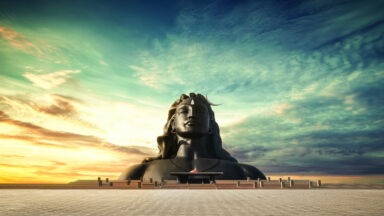An Ayurvedic Elixir for Total Rejuvenation

The Vedic sutras and ayurvedic texts, describe a sacred drink called soma rasa, said to beget eternal life. Soma rasa, also called amrita, is a Sanskrit word meaning “nectar of immortality.’’ Like the legendary “Fountain of Youth,” there are many speculations regarding the origin and location of soma rasa. The mythic stories of soma rasa describe its literal power in the human body. Soma is created internally within natural physiological processes, and harvested externally from plants and herbs. The correct utilization of soma rasa via meditation, diet, ritual, and yoga results in total rejuvenation of the human form.
The tantric systems in India, teach that soma rasa is made from moon’s waters. The moon is sometimes referred to as a cup the gods drink soma from to maintain their immortality. Every evening all the gods dip a finger into the moon-cup and drink the soma until the moon is empty.[i] Rituals described in the Vedic texts, still practiced in Tamil Nadu and Kerala, make soma from a plant harvested in the Himalayas. Some researchers theorize this is not the soma plant referred to in the Vedic texts, and believe soma is an unidentified, hallucinogenic plant, that grows in northern India and Nepal.[ii] The 9th Mandela in the Rg Veda, called the Soma Mandela, devotes 114 hymns to the purification of Soma, which is said to bring those who drink it to ecstasy. Other scholars hypothesize that soma is a bhasma, a type of ayurvedic medicine made according to rasashastra.[iii] Rasashastra is a type of alchemy medicine native to India, and involves the purification of metals and gems through a process of alternate heating, cooling, oxidizing and crushing, until a fine pure ash of consumable medicine is left, called a bhasma. Mercury, one of the primary metals used in rasashastra preparations, is thought to make the body perfect. Rasashastra is still practiced today, and takes years of specialized study under a master alchemist. Taking rasashastra preparations from untrained or unknown sources can be dangerous, and possibly life threatening.
The Hatha Yoga Pradipika teaches that meditation, specifically a practice called the kechari mudra, where a devotee inverts his tongue to touch the far recesses of his throat, and holds the posture for a period of time, will clear a membrane, and allow the secretion of soma to consistently drip from the sahasrara chakra.[iv] Meditation is taught to perfect the body so the practitioner can focus on gathering his internal winds, and bring the soma from the base of his spine up to the crown of his head, where the sahasrara chakra secretes soma rasa.[v] When soma rasa is secreted, the practitioner will experience bliss and immortality.
In the Sushruta Samhita, a classic Ayurvedic text, soma is described as having several plant origins, extracted in an elaborate ritual, that require building a house made of three chambers, where the center chamber is dedicated for the soma practice. The devotee begins with a series of specific mantras, pricking the bulb of the plant with a golden needle, and collecting its milky substance in a silver vessel, and drinks it. He then experiences soma’s effects over a period of four months, marked by distinct physical changes and practices, that include moving to different chambers for set days, applying and ingesting specific herbs, taking baths, and receiving specific massages. By the end of the fourth month, he is renewed physically, attains mastery over cosmological knowledge, never meets a failure in life, and is infused with divine spirit.[vi]
Soma has both, a metaphysical and physical means of transference. The substance of soma is pure love, and gives waves of bliss through our consciousness when it is ingested or produced. Exposure to the full moon, far away from city lights increases internal soma. It can also be cultivated in healthy lifestyle habits, extracted from plants, and produced in meditation. It requires a level of systemic function to be fully utilized, and therefore, cannot be accessed by sheer whim. Intentional support, facilitated by rejuvenation practices that restore digestive strength and detoxification, enable the extraction and proper assimilation of soma rasa.
Physically, soma is secreted by the glandular system. It is a finite manifestation of our immune system, and life force. The ancient Vedic texts indicate the place of soma secretion is the pineal gland, and some theorize that soma may actually be the powerful antioxidant called melatonin.[vii] As it is consumed, the body’s tissues become more elastic, and regain strength. The heart beats with a youthful vigor, and the mind sharpens. The shared teaching of the soma legend says, that immortality is not living forever, as we understand it, it is having enough physical strength and health, that the body is not an impediment to self-realization. The Vedic texts teach the desire to live forever is only worthy in order to completely actualize one’s full potential. The yogic and ayurvedic practices rejuvenate the body and restore vitality, so that we can ultimately transcend our physical body and reach enlightenment.
Moon’s Soma Drink
This is a drink that enhances soma production within the body and mind. It is best enjoyed after an evening meditation practice while basking under the light of the full moon.
Ingredients:
- ½ C Macadamia Nuts
- ½ C Brazil Nuts
- 4 C Purified Water
- 4 Thai Coconuts
- 1 T Turmeric Powder
- 1 tsp Pink Pepper
- ½ tsp Himalayan Salt
- 1 Vanilla Bean Pod
- ½ T Shatavari Root Powder
Directions:
-
Soak macadamia nuts and Brazil nuts in a bowl with 4 cups of purified water. Strain and discard water.
-
Put nuts in a high speed blender with 4 more cups of purified water. Blend at a high speed. Strain through a nut milk bag and set aside.
-
Crack open coconuts and pour coconut water into blender. Scrape out meat and add to blender. Blend at high speed until liquefied.
-
Add macadamia and Brazil nut milk back into blender with coconut milk.
-
Slice vanilla bean pod and scrape seeds into a small bowl. Blend into nut milk with the remaining ingredients. Pour into glasses and serve at room temperature.
References:
[i] Cashford, J. (2003). The Moon: myth and image. New York: Four Walls Eight Windows.
[ii] Jay, Mike. (1999). Blue Tide: The Search for Soma. New York: Autonomedia,
[iii] Mishra, L. C. (2004). Scientific basis for Ayurvedic therapies. Boca Raton: CRC Press.
[iv] Aiyangar, M. (1949). Haṭha-yoga-pradīpikā of Svātmārāma Svāmin ((3d ed.). Madras, India: Theosophical Pub. House.
[v] Fenner, Edward. 1(979). Rasyana Sidhhi: Medicine and Alchemy in the Buddhist Tantras. Madison, WI: University of Wisconsin.
[vi] Dash, S., Padhy., & Sachidananda. The soma drinker of ancient India: an ethnobotanical retrospection. Journal of Human Ecology, 19-26.
[vii] Bhatnagar, S. S., & Isaacs, D. (2009). Microchakras: innerTuning for psychological well-being. Rochester, Vt.: Inner Traditions.
What Your Dosha Type Means for Your Diet

Ayurveda is Sanskrit for “the wisdom of life.” Ayurveda originated in India and pre-dates modern medicine by thousands of years.
Ayurveda healing differs from modern medicine in the following ways:
- Focuses on preventative techniques, instead of merely reacting to illness as it arises
- Diet and habits are more strongly considered when diagnosing and treating
- Emphasizes on the uniqueness of the individual and finding what works for you personally
Three Types of Ayurveda Doshas
There are three types of Ayurveda Doshas – kapha, pitta, and vata. Doshas are more commonly known as mind-body types and are derived from the five elements.
While we all have aspects of each of the three doshas, for most of us, there is one dosha that dominates. You can also be a combination of two doshas, but that is less frequent. Before you learn about the characteristics of each type of dosha, determine which one(s) are most pertinent to you by taking this quick quiz.
I took this quiz with a little bit of healthy skepticism, not expecting anyone dosha to be that much stronger than the others, but for me, the traits corresponding to vata dosha are twice as strong. There are several dosha quizzes online, all of which gave me similar results.
Once you determine which dosha pertains to you, read about the strengths and weaknesses of that dosha and what dietary changes you can make to keep yourself in better alignment. While this article focuses on dietary modifications, there are all sorts of supplements, lifestyle and yoga practices that are also beneficial.





































